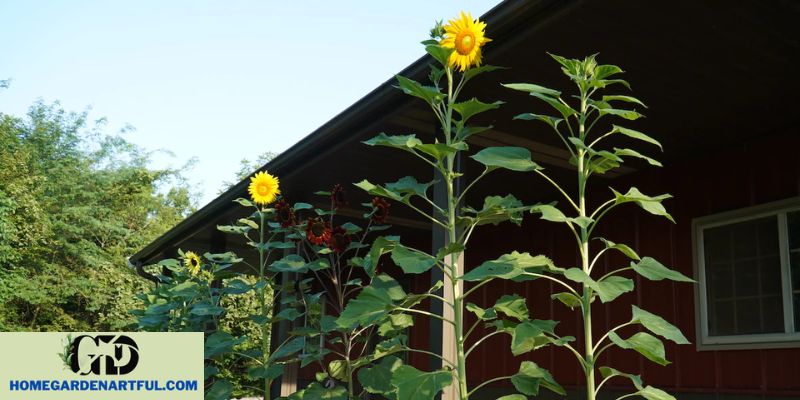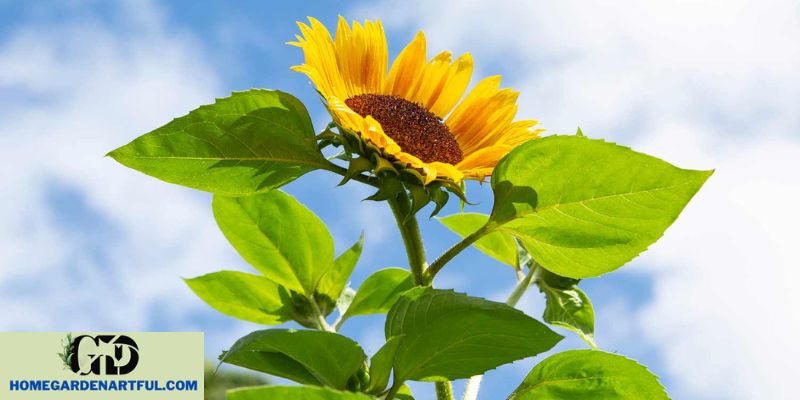If you’re looking for a unique and rewarding gardening experience, growing Russian Mammoth Sunflowers at home might be just what you need. With their towering height and large blooms, these sunflowers are sure to add beauty to any outdoor space.
It’s important to start with high-quality sunflower seeds to ensure a successful growth process. In this article, we will provide step-by-step instructions on planting and caring for your Russian Mammoth Sunflowers.
Key Takeaways:
- Russian Mammoth Sunflowers can be grown at home from high-quality sunflower seeds.
- These sunflowers are unique and add beauty to any outdoor space.
- This article will provide step-by-step instructions on planting and caring for your Russian Mammoth Sunflowers.
The Beauty of Russian Mammoth Sunflowers
Russian Mammoth Sunflowers are a unique and stunning addition to any garden. One of the tallest and largest sunflower varieties available, they can grow up to 12 feet high and produce flower heads up to 20 inches wide! These giant blooms are made up of hundreds of tiny, bright yellow petals surrounding a dark center disk, making them impossible to miss in any outdoor area.
While the classic yellow Russian Mammoth Sunflower is the most recognizable, there are also other varieties available, including the Red Russian Sunflower, with deep burgundy petals and a black center disk, and the Italian White Sunflower, with creamy white petals and a yellow center disk.
The Appeal of Russian Mammoth Sunflowers
The towering height and large flower heads of Russian Mammoth Sunflowers make them a popular choice for gardeners who want to add some drama and impact to their outdoor spaces. They are also a favorite among wildlife enthusiasts, as the large flower heads attract bees, butterflies, and birds, making them an important part of any pollinator garden.
But Russian Mammoth Sunflowers are not just a pretty face. They are also relatively low maintenance, requiring only well-draining soil, regular watering, and plenty of sunlight to thrive. They are versatile plants that can grow in a variety of outdoor settings, from large plots to containers on patios or balconies.
Planting Russian Mammoth Sunflowers

Planting Russian Mammoth Sunflowers is a relatively easy task, but there are specific steps you can take to ensure successful growth and blooming.
First, choose a location with plenty of sunlight and well-draining soil. These sunflowers need at least 6-8 hours of direct sunlight per day to grow properly.
Before planting, amend the soil with compost or fertilizer to provide nutrients for the sunflowers. Ideally, the soil pH should be between 6.0 and 7.5.
Next, dig a hole approximately 1-2 inches deep and place a sunflower seed in it. Cover the seed with soil and water gently. It’s important to space each seed at least 6 inches apart to avoid overcrowding.
After planting, water the seeds regularly, keeping the soil moist but not waterlogged. Once the sunflowers germinate, thin them out to one seedling per 6-8 inches.
As they grow taller, you may need to provide support by staking the stalks to prevent them from falling over.
Additionally, consider planting sunflowers in a location that provides a backdrop for them, such as a fence or wall, to give them additional support.
Nurturing Your Sunflower Seeds
Once you have planted your Russian Mammoth Sunflower seeds, it’s essential to care for them properly to ensure healthy growth and vibrant blooms.
| Watering: | Water your sunflower seeds regularly, especially during dry periods. Avoid overwatering, as it can lead to root rot. The soil should be moist but not waterlogged. |
|---|---|
| Fertilizing: | Apply a balanced fertilizer once a month during the growing season to provide nutrients for healthy growth. You can also add compost to the soil before planting. |
| Pest Control: | Keep an eye out for common sunflower pests such as aphids, slugs, and snails. Use organic pest control methods such as neem oil, insecticidal soap, or handpicking if necessary. |
| Disease Prevention: | Ensure proper air circulation around your sunflowers to avoid the onset of fungal diseases such as powdery mildew. Remove any infected leaves or flowers immediately to prevent further spread. |
| Staking: | As your sunflowers grow taller, support them with stakes or trellises to prevent them from toppling over in strong winds. |
By following these simple nurturing tips, your Russian Mammoth Sunflowers are sure to thrive and provide a stunning addition to your garden.
Sunflower Blooming and Harvesting
Russian Mammoth Sunflowers typically bloom from mid-summer to early fall, depending on the planting period and climate. As the flowers mature, watch for the petals to shrink and the center disk to turn brown. This is a sign that it’s time to harvest the flowers and collect the seeds for future growing projects.
When harvesting sunflower heads, use sharp scissors or pruning shears to cut the stem about 4-5 inches below the flower. You can also allow the flower to remain on the stalk until the petals have fallen off and the seeds are fully mature, which is indicated by the head drooping downward. To avoid birds and squirrels from eating the seeds, cover the head with a mesh bag or cheesecloth.
Sunflower seeds can be roasted, baked, or eaten raw. They’re a healthy snack and can also be used in a variety of culinary dishes, such as salads, granola, and trail mix. In addition to their culinary uses, sunflower heads make excellent decorations for dried flower arrangements or as a natural bird feeder.
Russian Mammoth Sunflowers in Containers

While Russian Mammoth Sunflowers are known for their height and stunning blooms, they can also thrive in containers. With the right care and attention, you can enjoy the beauty of these sunflowers even if you have limited outdoor space.
When selecting a container for your Russian Mammoth Sunflowers, it is important to choose one that is large enough to allow for adequate root growth. A container that is at least 18 inches in diameter and 24 inches deep should suffice. Opt for a container made of a lightweight material, such as plastic or fiberglass, to make it easier to move the sunflowers around if needed.
Fill your container with a high-quality potting mix that is rich in nutrients and has good drainage. You can also add compost or other organic matter to help improve the soil quality. After filling the container, water it thoroughly and allow any excess water to drain out before planting your sunflower seeds.
When planting your Russian Mammoth Sunflowers in containers, follow the same steps as you would for planting them in the ground. Plant the seeds about 1 inch deep and 6 inches apart, and water them regularly to keep the soil moist. Keep the container in a sunny location, and rotate it periodically to ensure all sides of the sunflowers receive equal amounts of sunlight.
As your sunflowers grow taller, they may need support to prevent them from toppling over in the wind. Consider using stakes or a trellis to provide structural support, being careful not to damage the roots in the process. Additionally, be sure to monitor the soil moisture levels and fertilize your sunflowers regularly to encourage healthy growth and blooming.
Growing Russian Mammoth Sunflowers in containers allows you to enjoy the beauty of these stunning flowers in any outdoor space. With the right care and attention, you can watch as your sunflowers grow tall and produce their giant blooms, creating a beautiful addition to your patio, balcony, or garden.
Russian Mammoth Sunflowers in the Garden
Aside from their impressive beauty, Russian Mammoth Sunflowers can serve as a natural privacy fence in your garden. Their tall stalks can create a barrier between your yard and the outside world while adding an element of natural elegance to your landscape.
In addition to their privacy benefits, these sunflowers also attract various pollinators such as bees and butterflies, making them a valuable addition to any garden ecosystem. As a bonus, their large blooms can also serve as a stunning focal point for any garden or outdoor space.
Using Russian Mammoth Sunflowers as a Privacy Fence
If you are looking to use Russian Mammoth Sunflowers as a privacy fence, it is important to plant them in a row, leaving a few feet between each seed. As they grow, their thick stalks and wide foliage will form a natural barrier. Ensure you are planting them in an area with plenty of sunlight and use stakes to support taller plants.
Incorporating Russian Mammoth Sunflowers into Your Garden Design
Russian Mammoth Sunflowers can add height and texture to your garden and are a great option for planting against a wall or fence. You can also plant them in clusters amongst other flowers to provide a dramatic contrast in size and color. Be creative and experiment with different placement options to find what works best for your garden.
Russian Mammoth Sunflower vs. Other Varieties

Russian Mammoth Sunflowers are a popular choice for gardeners due to their unique size and beauty. However, they are not the only giant sunflower available. There are other varieties that can make just as much of a statement in your garden.
American Giant Sunflower
The American Giant Sunflower is another popular choice for gardeners who love large flowers. Like the Russian Mammoth, it can grow to be over 10 feet tall and has a large flower head. However, the American Giant’s petals are a brighter yellow than the Russian Mammoth’s, and its flower head can be slightly smaller.
Mongolian Sunflower
The Mongolian Sunflower is a unique variety that boasts multiple flower heads on a single stalk. While each individual flower head is smaller than that of the Russian Mammoth or American Giant, the abundance of blooms creates a beautiful effect in the garden. Additionally, the Mongolian Sunflower is known for its drought tolerance, making it a great choice for areas with low rainfall.
When it comes to choosing between Russian Mammoth Sunflowers and other varieties, it ultimately comes down to personal preference and the effect you want to achieve in your garden. Consider the size and color of the flower head, as well as the height and growth habits of each variety, before making your final decision.
Fun Facts and Uses of Russian Mammoth Sunflowers
Russian Mammoth Sunflowers are not only beautiful to look at but also have fascinating uses and facts. Here are some interesting insights:
- One sunflower, multiple flowers: Did you know that a single sunflower head can have up to 2,000 individual flowers?
- Food for pollinators: Russian Mammoth Sunflowers are an excellent source of food for pollinators such as bees and butterflies. Their nectar and pollen provide essential sustenance to these important insects.
- Seeds for snacking: Sunflower seeds are a popular snack food, but did you know they are also highly nutritious? They are rich in healthy fats, protein, and minerals such as zinc and magnesium.
- Industrial uses: Sunflower seeds are used in the production of a variety of industrial and consumer products, such as biodiesel, soap, and even cosmetics.
- Cultural significance: Sunflowers have been revered throughout history for their unique beauty and symbolism. They have been used in various cultural practices, such as tribal ceremonies and art.
With such a range of fascinating uses and facts, it’s clear that Russian Mammoth Sunflowers are more than just a pretty face. Incorporating them into your garden design can not only add beauty but also contribute to the wider ecosystem and even your own well-being through their health benefits.
The Lifecycle of a Russian Mammoth Sunflower

Helianthus annuus, commonly known as the sunflower, is a fast-growing, hardy annual plant characterized by its large, vibrant yellow flowers and towering height. The Russian Mammoth Sunflower is a variety of sunflower that can grow up to 12 feet tall and produces huge heads covered in small, edible seeds.
The lifecycle of a Russian Mammoth Sunflower begins with planting the seeds in nutrient-rich soil during the springtime. The seed germinates within a week or two, pushing through the soil to reach the surface and absorb sunlight. The seedling grows quickly, producing its first set of true leaves just a few days after sprouting.
As the plant grows taller, it develops a strong, sturdy stem that supports the weight of the flower head. The sunflower bud forms at the top of the stem, tightly packed with hundreds of florets waiting to bloom.
Once the sunflower is mature enough to bloom, the tightly packed florets begin to unfold, revealing the stunning yellow petals that capture the sun’s warmth. As the sunflower continues to grow, its head becomes heavy and begins to bend downward, facing the sun as it tracks across the sky.
As the summer comes to an end, the sunflower’s blooming period ends and its seeds begin to mature. The disk-shaped flower head dries and turns brown, and the seeds become plump and firm. Once the sunflower head is fully mature, the seeds can be harvested for use in cooking or planting, or left to attract birds to the garden.
Two Sunflowers from One Seed
One unique phenomenon that sometimes occurs with Russian Mammoth Sunflowers is the growth of two flower heads from a single seed. This phenomenon, known as fasciation, causes abnormal growth in the stem and results in a flattened, ribbon-like flower head with two distinct sunflowers emerging from it. Although not common, it adds an interesting twist to growing sunflowers and is sure to be a conversation starter in any garden.
Caring for Your Russian Mammoth Sunflowers
While Russian Mammoth Sunflowers are relatively easy to grow, they still require proper care throughout the growing season. Here are some additional tips and tricks to ensure your sunflowers thrive:
- Pruning: Remove any broken or diseased leaves or flowers to promote healthier growth. Deadheading, or removing spent flowers, can also help redirect the plant’s energy towards producing new blooms.
- Fertilizing: Sunflowers benefit from regular fertilizing throughout the growing season. Use a balanced, all-purpose fertilizer and follow the package instructions for application.
- Pest control: Keep an eye out for common sunflower pests such as aphids, caterpillars, and earwigs. If detected, treat with an appropriate insecticide or remove affected parts of the plant.
- Staking: As your sunflowers grow taller, they may need support to prevent toppling over. Use stakes or a trellis to prop up the stalks and prevent them from breaking.
- Watering: Sunflowers need consistent watering throughout the growing season, especially during hot and dry periods. Water deeply at the base of the plant, rather than overhead, to avoid wetting the leaves and increasing the risk of disease.
- Protecting from weather: In case of strong winds or heavy rains, it’s a good idea to stake your sunflowers or cover them with a protective cloth or plastic to prevent damage to the stalks and flowers.
By following these simple care tips, you can ensure healthy growth and vibrant blooms from your Russian Mammoth Sunflowers. Watch them tower over your garden and enjoy the beauty they bring to your outdoor spaces!
Conclusion
Growing Russian Mammoth Sunflowers at home can be a fulfilling and rewarding experience. These towering beauties can add unique beauty and height to any garden, and their giant blooms are sure to impress.
By using high-quality sunflower seeds and following proper planting and care techniques, you can ensure successful growth and blooming. Whether you choose to grow them in containers or incorporate them into your garden design, Russian Mammoth Sunflowers are a versatile and impressive addition to any outdoor space.
Remember to care for your sunflowers throughout the growing season, pruning and deadheading as necessary to promote growth and prevent common sunflower ailments.
We hope this article has inspired you to embark on your own Russian Mammoth Sunflower growing journey. Happy gardening!


